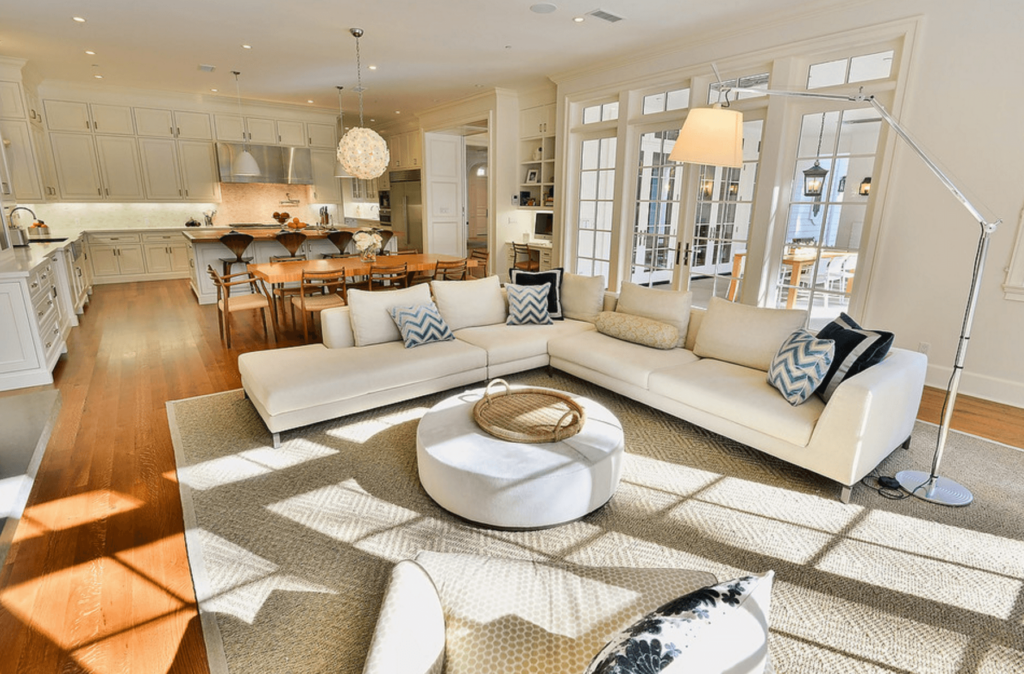Having a peaceful home is more important for one’s mental health in today’s hectic environment than ever before. A well-planned environment has the power to alleviate tension, encourage calmness, and heighten awareness. Research shows that people experience more anxiety and tension in disorganized or chaotic settings, while they feel more at ease in quiet and ordered ones. Whether you’re building from the ground up or just want to make some changes, these mindful home design suggestions will help you make your house a more peaceful and quieter place to live.
Get Your Mind Clear by Decluttering
Having a location that is disorganized and difficult to navigate might contribute to an increase in stress levels. People whose houses they regarded as disorganized or chaotic were more likely to have elevated cortisol levels, according to research published in the Personality and Social Psychology Bulletin. Decluttering is the first step in creating a peaceful living area. This doesn’t imply getting rid of anything, but rather clearing out what you no longer need.
As a general rule, whenever you add anything new, take something away. This is called the “one in, one out” rule.
One advantage of a minimalist and well-organized house is the calming effect it has on the psyche.
2. Embrace the Light of Nature
When designing a soothing atmosphere for one’s house, lighting is of paramount importance. Mood, anxiety, and sleep cycles may all be improved by exposure to natural light. The American Psychological Association found that being outside in natural light helped reduce feelings of sadness and anxiety.
Light, thin curtains or blinds will let in the most natural light, so don’t use thick drapes that obstruct it.
The positive effects of natural light on your mood and the quality of your environment are amplified when you let in more sunshine.
3. Use Colors That Promote Relaxation
Some colors may have an effect on how we feel and how much stress we can handle, according to color psychology. It is well-known that a soothing home environment may be achieved by using soft, neutral tones like mild blues, greens, beiges, and grays. According to a Houzz poll conducted in 2020, more than 60% of those who took the survey said that neutral tones helped them relax in their homes.
Advice: To alleviate tension, decorate your walls, furniture, and accessories with soothing colors.
Advantage: Subdued hues promote calm and ease, making for a more peaceful and reflective home environment.
(4) Utilize Organic Components
An important part of eco-conscious home design is bringing the outside inside. A more relaxed and healthy state of mind may be achieved via the use of houseplants, natural materials, and organic textures. Journal of Physiological Anthropology research suggests that interacting with houseplants may alleviate stress in two ways: mentally and physically. This is because plants have a calming effect on the sympathetic nervous system.
Advice: Bring in some houseplants, such as snake plants, fiddle leaf figs, or peace lilies. Also, while decorating your home, try to use natural materials such as wood, stone, and cotton.
Advantage: Being surrounded by nature helps you relax and focus, since it establishes a connection to the outdoors and gives you a sense of stability.
5. Adhere to simplicity
Beyond mere aesthetics, the emphasis on simplicity and practicality in minimalist home design promotes awareness. Improved concentration and less stress may be achieved with a better organized space with less unnecessary items and a clearer structure. A minimalist home is one that is harmonious and uncluttered.
Advice: Pick out just the most important items and furnish them with minimalist pieces. Instead of going for quantity, go for quality when choosing your decor.
Advantage: Living in a minimalist house promotes relaxation, calmness, and awareness.
6. Set Up Peaceful Areas for Mindfulness Exercises
If you want to remain centered and present, it could help to designate some space for meditation or silent reflection. These spots should be quiet and undisturbed so that you may concentrate on your yoga, meditation, or self-reflection.
Advice: Find a quiet spot, even if it’s only a corner, and make it your own space to meditate or practice mindfulness. A tranquil haven may be yours with the help of plush pillows, a warm rug, and soothing lighting.
A place to relax and unwind from the stresses of everyday life, these areas promote mindful living practices like meditation and contemplation.
7. Incorporate Calming Aromas
When used in the comfort of one’s own home, aromatherapy may do wonders for one’s mood. Lavender, chamomile, and eucalyptus are some of the most well-known aromas that have a calming effect on people. Aromatherapy has the potential to boost mood, reduce stress, and facilitate relaxation, according to research published in the Journal of Alternative and Complementary Medicine in 2023.
One helpful hint is to infuse your house with the aroma of relaxing essential oils using a diffuser, scented candles, or incense.
Advantage: Scent has the power to turn your house into a tranquil sanctuary, bringing you a sense of balance and serenity.
8. Careful Arrangement of Furniture
The energy of a room may be greatly affected by how you arrange the furniture. If the space is too cramped or poorly organized, the energy can’t flow freely, and that might make people feel uneasy. Instead, go for a design that promotes mobility and openness to let good energy flow freely.
Advice: Put the concepts of Feng Shui into practice or just make sure your furniture is set up in a manner that makes you feel at ease and makes good use of space.
Advantage: A well-planned arrangement of furniture may provide the illusion of additional space, leading to a more serene and balanced atmosphere in the house.
9. Audio Is Crucial
An oasis of tranquility may be achieved via the strategic use of sound. Ambient, gentle sounds may help relax the mind, but disruptive, loud noises might agitate it. A research published in the Journal of the Acoustical Society of America found that listening to nature sounds, such as rain, birdsong, or ocean waves, may help decrease stress and heart rate.
Recommendation: Play calming music, use a natural sound machine or app, or bring calming noises into your house.
The ability to relax and concentrate is improved in a setting with little background noise, which is a benefit of the mindful living method.
10. Be Open to Personalized Elements
Although a minimalist and clutter-free home is necessary for relaxation, it’s the little things that make a big difference in making a house a home. Incorporating important artwork, antiques, or family pictures into your house may provide a sense of joy and stability, enhancing your home mindfulness practice.
Advice: Keep things simple when displaying things that mean a lot to you, such as a few framed photos or a little piece of artwork.
The advantage is that when you add your own unique touches to your home, it becomes more like a sanctuary where you can relax and unwind.
Reflections on a Mindful Life and Home
Rather of focusing on strictly adhering to a set of guidelines, a mindful house should reflect the individual’s need for calm, serenity, and awareness. Make your house a haven that nurtures your mind and spirit by incorporating these mindfulness practices, which range from purging unnecessary items to adding soothing music and color.
A stress-free existence, replete with moments of relaxation and rejuvenation, may be yours with the aid of a mindfully designed space. Creating a relaxing home is a process that never ends; it changes and adapts to your requirements. Pay close attention to how your environment affects you, and make adjustments as needed to ensure that it provides you with the peace and quiet you want.







